Menus
- TGV first class
- Discovery
- In the saddle
- In the city
- Motorway and expressways
- Departmental
- Cycle part
- Braking
- Comfort / Duo
- Consumption
- Conclusion
- Colors
- Standard equipment
TGV first class
Five years ago, Kawasaki presented its first Z1000SX, a road version of its Z 1000 reference roadster. A versatile machine, which has become queen of the sport-GT segment, the Akashi reference experienced a first evolution in 2014, mainly giving it a more elegant luggage attachment system and better quality suspensions and braking. The 2017 vintage wants to further optimize the sport-comfort compromise, reinforcing the appearance and sporting potential as much as the comfort of the crew. Its radical lines, however, offer superior ergonomics and improved protection. Particularly stylish, the new road Ninja also boosts its electronic assistance by adopting a multiaxial inertial unit.
A contrasting test on the Côte d’Azur, mixing wet winter conditions and a mild late season, highlighting the sublimated qualities of the Kawasaki.

Discovery
Third iteration of the SX model, now Euro4 homologated, the benchmark Sport-GT adopts an even sportier style in the service of first-class road capabilities. A desire that is reflected in the new line without concession of novelty, displaying a double personality. If the rear half of the machine evokes travel and duo, especially with the luggage, the front is inspired by the hypersport ZX10R, increasing tenfold a style started on the trail Versys 1000.
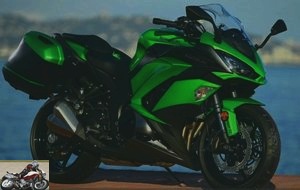
As is often the case, the machine is much more attractive in real life than in studio photos and streamlines a previously hesitant aesthetic. Without compromise, the new front end has one of the most remarkable sporty elegance. Its entirely LED lights combine vertical faces and flat flats, inlaid in the sharp angles of the fork crown. Its sharp volumes, mimicking mini fins at their end, widen wider towards the pilot (+56 mm), dominated by a slightly redesigned notched bubble. Always adjustable by pressing a button under the dashboard, it switches to three positions, ie 20 ° of amplitude. Its central crown increases by 15 mm and the double curvature surface increases. Laterally, the Z1000SX evolves significantly, streamlining its lines with new fairing elements. Very discreet, subtly integrated scoops, biton trim and front indicators barely protruding from the surfaces, the sides then cut elegantly around the engine. Much more harmonious and better dissipating the calories of the mechanics, this set encloses the triangular volume, with prominent shoulders, of the 19-liter tank. It is supported by a thicker and wider rider’s seat, surmounted by a more comfortable (+ 3mm thick) and longer (+ 25mm) passenger seat. Previously optional, the touring version grab handles of the companion, curved and integrating the suitcase supports, are offered as standard. More ergonomic, these models require less gripping effort compared to the horizontal elements of the first versions. Stylish, the suitcases each house a full-face helmet. Fully sheathed, the stern ends with a LED light and rests on a rear loop made of three pieces of die-cast aluminum.
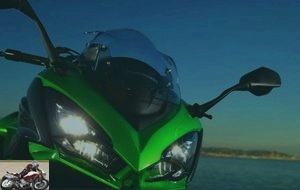
The assembly rests on a double aluminum beam frame passing above the engine with load-bearing function, which makes it possible to narrow the machine. Five die-cast aluminum parts (steering column, left and right main pillars and two transverse joints) are attached to the engine by four brackets. Renewed without major changes, the 1,043 cc, dual ACT, 16-valve four-cylinder features a super square bore-to-stroke ratio of 77.0 x 56.0 mm. These values favorable to high speeds benefit from a double butterfly injection (with ovalized secondary ducts) which allows the engine to deliver torque at low and mid-speed. The use of these secondary elements, controlled by a computer, artificially reduces the passage section of the mixture, in order to optimize the filling of the cylinders, whatever the engine speed. Likewise, the collectors have interconnections favoring the driving force. Thus, the unit delivers 142 hp at 10,000 rpm and 11.1 da.Nm of torque at 7,300 revolutions per minute. Note the adoption of a new secondary balancer to limit vibrations.
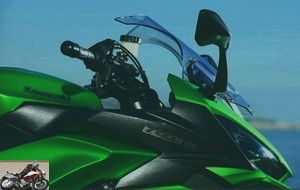
Devoid of a ride-by-wire throttle grip, the Z1000SX does not forget the piloting assistance, renewing the systems present on the old model. It still offers two injection maps, Full and Low. The first gives full mechanical performance, the other reduces its capacity by 75% (106 hp) and modulates the engine response. Another element of this electronics, theKTRC anti-slip, can be deactivated and configured on three levels from the console to the left chest of drawers. Mode 1 keeps maximum traction in sporty driving, but also leaves more drifts to the rear wheel. Mode 2 further limits glide and Mode 3 activates as soon as a loss of grip is detected. The latter is particularly dedicated to slippery conditions.
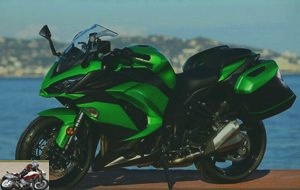
Another valuable piece of equipment is the"Assist & Slipper" clutch uses two types of cams (a lock cam and a slip cam) to compress or separate the pressure plates from the clutch housing. The first relieves the clutch spring, softening the drive. In the event of excessive engine braking (downshifting too fast), the sliding cam then comes into action. It separates the pressure plates from the clutch housing. This relieves the force exerted on the clutch discs, limiting rebound as well as locking the rear wheel. Finally, the reduction in the number of springs (3 instead of 5 on the previous version) greatly relaxes the lever engagement force..
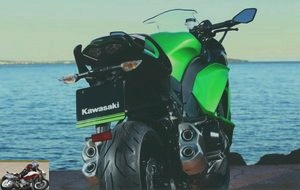
Since its inception, Akashi’s sport-GT incorporated efficient aids, such as ABS and KTRC traction control. The latter uses minimalist on-board equipment: apart from the engine ECU (throttle opening, gear engaged, speed) the system is based on the speed sensors of the front and rear wheels. Relevant, these systems are revolutionized on the new Z1000SX. Electronics made a leap forward with the adoption of a Bosch inertial unit (IMU), to boost the already existing assistance. Thus, a very small box monitors the inertia along 6 axes. Longitudinal, transverse and vertical acceleration, roll angular speed and pitch speed are controlled. These continuously analyzed data ensure finer management of traction control (KTRC) and ABS (now KIBS), mainly on the angle. This set of functions thus makes up the KCMF, management of cornering. In curves, the IMU will eventually regulate the braking force and the engine power throughout the trajectory, intervening on the brakes and traction control. Through its predictive work, the KCMF helps to more easily put the machine in the target path, throughout the turn. Indeed, the system no longer waits for slipping or blocking, but can now anticipate problems by knowing the movements of the vehicle ….!
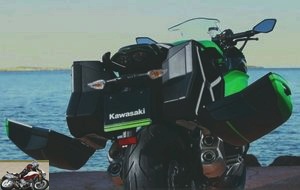
This beautiful battery of chips is based on a high quality cycle part, with ribs promoting dynamic and lively behavior. Thus, the column angle is 24.5 ° and the wheelbase contained with 1,440 mm (-5 mm). There is also an inverted 41 mm fork, fully adjustable by a progressive system. In cast aluminum, the swingarm is entrusted to the care of a Kayaba shock absorber whose stroke lengthens by 6 mm (144mm), adjustable in rebound and preload. The latter is modulated via a qualitative wheel offset on the right passenger footrest plate. The horizontal positioning, Back-link type of this suspension frees up the space otherwise occupied by the lower link. This configuration optimizes mass centralization, placing the catalyst under the machine. Only the two short silencers frame the bottom of the machine. However, this configuration prohibits the possibility of placing a central stand..
The 6-spoke aluminum rims fit Bridgestone S20 wraps in 120 and 190. To stop their momentum, two Tokico monobloc calipers with 4 opposed pistons and radial mounting, like the master cylinder, attack discs with petal frets of 300 mm. The opposing single piston retarder grips a 250mm disc. Smart ABS (KIBS) is standard, but elbow valves are not.
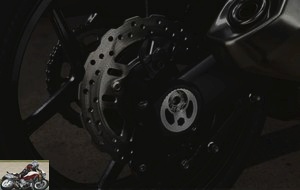
Construction, quality of components and finishes are of high level, giving the Z1000SX an image of high-end road. Although not very visible, the engine block takes care of its appearance and limits unsightly peripherals. Hoses and cables are well integrated, metal and plastic surfaces enhance the aesthetics of the Kawasaki.
In the saddle
More accessible with 815 mm, or 5 units less, the pilot’s seat is also more pleasant, allowing a little greater recoil and a better piloting position. Especially since the saddle arc is further reduced at its junction with the tank. Reasonably bent legs, the bust tilts with just the right amount of sportiness on the half-handlebars. Little inclined and fairly open, these elements support good-quality and ergonomic controls.
Like its predecessor, the Z1000SX sports an analog tachometer and an LCD window, but the latter is much larger and offers a negative display. The engine speed dial wisely encircles the gear engaged indicator (finally available) and the clock. In the large remaining space are the total mileage, partial mileage (two totalizers), remaining range, average and instantaneous consumption, outside temperature (new in 2017), coolant temperature, time and temperature. economic driving indicator. The left stalk controls this information, but also and above all, the KTRC electronic assistance and mapping. A central push-button is used to select the data to be configured. Particularly fast and intuitive, the whole attracts nothing but praise. Only regret: the lack of cruise control…
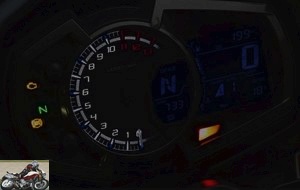
A new shiftlight configurable from 5,000 to 11,000 rpm, (increments of 250 rpm) indicates the possible need to upshift. It is combined with the color change of the tachometer needle which turns from white to pink, then to red depending on the determined range. My slight color blindness will hardly tell you about the interest of this point…. Everything takes place in a neat cockpit overlooking a fork then just as well finished. Only note, the positioning of the instrument block follows the plunging line of the machine, projecting it a little deep and far from the eyes.
Finally, the clutch lever is now adjustable in spacing in 5 positions, that of the brake in 7 increments and the mirrors are further apart by 20 mm, offering a greater range of adjustment.
In the city
The Kawasaki Z100SX has been blowing since its birth an ample chanting made of bass then more metallic trills. This typical sound, still relevant today, is the result of a great deal of work on the airbox and the exhaust. In fact, a characterful four-cylinder drives its bowels and lets it know. Without excess, but with determination, definition befitting the personality of this machine. And its new LED front lights give it an original and modern light signature..
The softness of this mechanism is another pleasure in urban evolution. With incredible flexibility, the unit resumes at idle speed on the last report at 30 km / h, without flinching…. More generally, staying out of the way is the norm. The obviousness of the machine is another constant. Despite a rear tire in 190, the sport-GT is easy to maneuver, fitting naturally into the uncertain traffic of the Estelle. Low, it allows good control on all occasions. Only the U-turns admit a turning radius in the standard, nothing more.
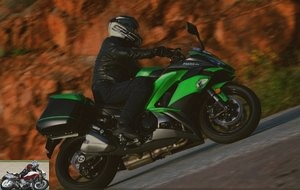
The mirrors return an excellent field of vision, free of vibration and, larger, these new mirrors also indicate the outer limits of the suitcases…. Do not forget these useful appendages can avoid many setbacks.
Whatever the gear engaged, the injection is precise and sometimes generates only slight jolts. Associated with a gearbox as precise as it is soft and an almost imperceptible clutch lever, the Touring Ninja is more zen than urban combat. Finally, do not trust it too much…. because the warrior is not far and ready to run on the horizon.
Motorway and expressways
On board the Z1000SX, we could drive for hours at average speeds hardly allowed…. especially if one is more adept of sport than GT, martial art than yoga. The protection offered by the sharp road is very acceptable. The ideal compromise between dynamism and comfort, evolution 2.0 refines this recognized quality. Its adjustable bubble provides a slight increase in comfort. And in the rain, any runoff ideally flees towards the bust and not the visor. Finally, the course with the two 28-liter suitcases is impeccable, even out of legal speed..
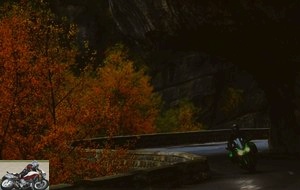
It is above all its new fairings that provide real additional protection. The top of the shoulders and the helmet remain subject to the air flow, but the fluid lining does not generate any turbulence. Bust and leg therefore shelter properly and only the feet can take more air…. or water. My left boot, which was not waterproof, ended up informing me about it under the Provençal deluge. The right remained dry, probably due to the shape of the crater on this side.
At 130 km / h, the mechanics touch the 5,500 laps on a sixth report, however, retaining good revivals. In the general tranquility, we meditate on the absence of a cruise control. Especially since the vibrations, now well attenuated by the new balance shaft, make journeys on priced tape more pleasant. This remark is the opportunity to leave this soothing route for a more varied route..
Departmental
How beautiful the mountain is, adorned with its autumn colors…. that the rain makes sparkle. I find it hard to believe and read the number on my screen. It’s 6 ° C…. but the mediocre brightness makes reading difficult. Perfectly visible at night and in direct sunlight, these particular lighting conditions affect the perception of the smallest indications. Otherwise more readable, the most essential are those of the KTRC, or even the cartography. Set to Low, the latter largely retains enough to power the stylish road. Remember, 106 horsepower was the norm there is…. not that long. Enough to make the rear tire spin copiously on each white strip where I test the system. Astonishing? Not necessarily. Modes 1 and 2 promote acceleration and, under the control of its new inertial unit (IMU), the Z1000SX knows it is right…. On the other hand, if the machine gets in the way appreciably, the regulation intervenes very quickly. And the implementation is particularly smooth. Permissive, the system modulates wisely. It is thus able to accept wheelies (KTRC mode 1 and 2, less invasive) if they are due to the torque, but to regulate much more effectively if this is due to a bump…. And, good news, these figures of speech are easier to achieve, because under control…. Even the weight of the luggage or the passenger is taken into account (depression of the plate) !
In cold water, the Bridgestone S20 are also not stingy when it comes to gliding…. in the front. But in full transparency. They therefore provide effective information on precarious adhesion. The discretion of the KIBS is also remarkable, barely noticeable in the lever or pedal.
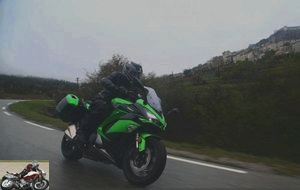
Benefiting from a second drier day of testing, I found a Z1000SX bluffing sporting efficiency, especially since the inertial unit takes care of the unexpected. On the drying asphalt of Les Adrets, an essential route for any biker, I can finally tackle the ferrule as it should. Full at any speed on the intermediate reports, the Japanese four-cylinder changes behavior beyond 6,000 rpm, then reinforcing its thrust with each graduation of the tachometer. It pulls fat out of a corner on the corner, martyring the tires which drive perfectly. And no need to be slack on the wrist. In the event of an overloaded stimulus, the KTRC activates, always smoothly, avoiding the pitfall that physics would otherwise have given you. Faster and more relevant, because now predictive, the system provides an even more precise response. In mode 3, the KTRC also modulates ignition timing, air supply and regulation (via secondary throttles) and reduces engine power until grip is regained by the rear wheel. At start-up, mapping and traction control remain at the last desired setting (except deactivation of the KTRC).
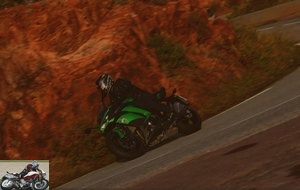
Addictive, this safety allows you to drive hard and lets the crew spring to the next turn. The Kawa leaps into the deep breathing of the airbox and the shrill exhaustion when the shiftlight lights up. Agile and precise, the machine easily allows course corrections. With an important angle, it is sometimes necessary to force on the footrests, the rear envelope in 190 oversteering a bit. Ideal for passing the driving force, this dimension nevertheless retains good ease on the road. But it is indeed a 235 kilogram machine that we take, without counting the suitcases and the inertia is sometimes felt on the rapid changes of angle. The basic comfort setting also explains this phenomenon, which is amplified by a very fast pace. Not a real fault therefore, especially as the suspension can be adjusted more sportily.
Considering the proximity of the turn, it would be time to take the brakes. And even to keep them on the corner, because the KIBS watches over your approximations. Integrating the ECU parameters of the engine (throttle opening, engine speed, request of the clutch and gear engaged) the front / rear wheel differential and now the position of the vehicle, it adapts the hydraulic pressure of the front calipers and significantly limits the righting or stiffening of the direction. It also prevents the rear axle from shedding too much, leaving the Z1000SX perfectly in line even on the strongest decelerations. The modulation of the braking forces also makes this phase more progressive. One-finger actuated lever provides control and power to the front grippers.
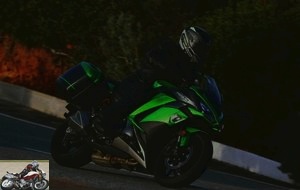
This neutrality is also the result of a remarkable damping. Adopting a rather comfortable profile by default, the suspensions are easily adjusted and allow to keep a very high pace for anyone who is up to the potential of the Ninja GT…. No parasitic movement affects evolutions at a sporting pace. And, in contemplative mode, the Kawa turns into a charming road, so much serenity inhabits the crew. Absorbing all the defects of the bitumen with equal efficiency, the Z1000SX is endowed with one of the best behaviors and equipment at this level of the range. And, always available, the Japanese block coats its raw strength with an unusual softness..
Cycle part
With one of the best suspensions in the segment, the Z1000SX is unperturbed. On the angle, it keeps its course, whatever the coating and its rigid chassis makes it a corner chaser. Adjusted, shock absorber and fork can make it even more incisive.
Braking
The decelerations could, on the strongest braking, offer a more consistent feeling. An observation to be tempered due to the use of electronics, optimizing deceleration. However, this feeling could displease the more sportsmen who want a more sensitive control of the calipers. But the power is very sufficient and the radial elements allow good control at the lever. Equally effective, the rear clamp perfectly supports opposing retarders. Finally, the ABS is triggered only wisely and with great neutrality, without straining a sporty steering..

Comfort / Duo
A successful compromise, the ZX1000SX allows you to ride far and long. Optimized sidewall volumes and new bubble deliver superior protection. The new seats significantly improve comfort for both the pilot and the passenger. The latter will appreciate the standard touring handles. Finally, the suspensions deliver high quality damping due to their progressiveness.
You always have to choose between side cases OR top case…. Not that the line suffers, but the stability at high speed, yes, according to the engineers.
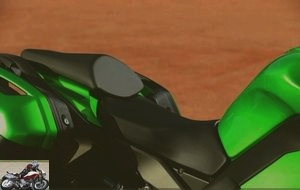
Consumption
During our 277 km test in the rain, the average fuel consumption was 6.6 liters per 100 km. In the sun and with a more committed piloting, 6.9 units. The 19 liters capacity of the canister can therefore take you far before quenching the thirst of your dynamic horse..
Conclusion
Dressed in an elegant sportiness, the new Kawasaki Z1000SX is once again improved. The compromise is more than convincing, this vintage bringing a welcome addition of comfort. But the novelty concedes nothing in terms of efficiency. Its four-cylinder combines smoothness and explosiveness to best follow the versatile road pretensions of the machine. Comfortable and agile, the Japanese significantly optimizes its ease and performance with simple electronics increased tenfold by its inertial unit. True plus, especially at a good pace, the system convinced us by its relevance.
Its only opponent in the segment is the BMW R1200 RS that we opposed last year. With this evolution, the Bavarian loses a lot in terms of performance and finesse of the electronic assistance. Priced at 14,105 € in the basic version, it claims 16,145 € to rub Japanese. (1,445 € for the Touring Pack: ESA, regulator, central stand, luggage rack, suitcase supports….) And 595 more for the Dynamic Pack (including DTC, driving mode….). Estimated between € 13,500 and € 14,000, Akashi’s road will be equipped with suitcase and heated handles with the differential.
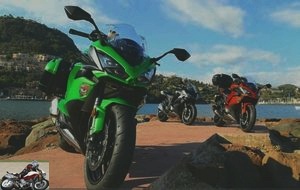
Always more versed in the sport than its German counterpart, the Kawasaki Z1000SX seems very well placed to take back the leadership of sales. This high-speed road awaits you in premium class from December.
Strong points
- Aesthetic
- Equipments
- Engine character and availability
- Anti-dribble clutch
- Electronic
- Sportiness
- Sound
- Comfort and protection for the segment
Weak points
- Lack of cruise control
- Dashboard out of sight
- No angled valves
Kawasaki Z1000SX technical sheet
Colors
- Candy Lime Green (green) / Metallic Carbon Gray (gray)
- Metallic Spark Black (black) / Metallic Graphite Gray (gray)
- Candy Burnt Orange (orange) / Metallic Carbon Gray (gray)
Standard equipment
- Passenger touring handles
- 6-axis inertial central
- Three-level KTRC
- ABS – KIBS
- Two engine maps
Related articles
-
Kawasaki Ninja 1000 SX motorcycle test
Compromise without compromise 4 cylinders of 1,043 cm3, 142 hp and 111 Nm, 235 kg, from 14,349 euros In 2010, Kawasaki presented its first Z1000SX, a…
-
Closely derived from competition, the Kawasaki KX 250 F and KX 450 F combine innovations and off-road performance. Struggling at the best level, they are…
-
Roadster with Sugomi sauce or decarenated sports car A2 licenses have the choice between large bridles, sometimes very badly bridled, and smaller ones,…
-
Kawasaki 1400 GTR motorcycle test
THE GT There always comes a time when every motorcyclist wonders about the positioning of his passion. And the current offer, with its various…
-
Cruise missile The ultimate breed of sports cars, the Kawasaki ZZR 1400 is a living myth; the last witness to an almost vanished age when speed and power…
-
2010 Kawasaki Z1000 motorcycle test
The right machine for the bad boys ! Initiated in 1972, the Z saga is a story of heavy mechanics and strong character. After the 900 cc Z1, the first…
-
Kawasaki Versys 1000 SE motorcycle test
3rd evolution for the shock road trail hybrid 4 cylinders in line, 1,043 cm3, 120 hp and 102 Nm, KECS electronic suspensions, 257 kg, 16,899 euros…
-
4 cylinders in line, compressor, 998 cm3, 210 hp at 11,000 rpm, 137.3 Nm at 9,500 rpm, 260 kilos, € 21,999 Kawasaki reinvents the super-fast and…
-
The small large gas turbine The brand’s historic sports car, the CBR 600 RR is a sure bet for efficiency and performance. Rather than the ultimate quest…
-
Road bike 173 horses Presented in early 2010 as the synthesis of Honda know-how, both mechanically, qualitatively and technologically, the VFR 1200 did…
Hello,
I had the opportunity to try the XR this Friday after doing the same with the Tracer GT in a renewal project.
The Tracer is known with an engine that keeps pushing, but a stance that is too roadster-like for me.
The BM is also very nice. Pass the heavy front end that engages for the first few meters, the position is pleasant with less bent legs but the bust a little more forward.
The bike is stable and gives less the feeling of "pumping" than the Tracer, typed longer and that suits me better.
The protection is almost identical on the 2 motorcycles with a little more pronounced turbulence on the Tracer with the screen in the high position.
There remains just a rocking horse side under braking a little too pronounced. The braking is also very powerful, limit violent but you get used to it quickly.
Finally, the engine. You have to get past the noise of the Bm pan and iron, not very flattering, and afterwards it has a very linear side but with watts. I liked it anyway because less inclined to crime than CP3.
Then I’ll be curious about the upcoming comparisons between the 2. The Bm will be less demonstrative but will it be less efficient ?!
That was my opinion at 2 €
Interesting your feedback.
For having also tried the BM and over 400 km, I was a little disappointed with the F900XR.
It’s not a bad bike, it’s pretty good. But she leaves something frustrating.
It is not its chassis or its finish, or its equipment, but on the whole.
Frustrating in feeling, these are much more present on my Ninja 650, both in character and in pleasure at the same pace, it was already the case with the F800R. Too smooth and almost bland. This linear motor, no matter where it comes from (it’s always a shame coming from a brand like BMW), it would have deserved to be at least animated like a Triumph 765, Z900 or Tracer 900, especially for a BMW brand of "Motorist" and at the current price. It’s not bad either, but we say to ourselves that they could have put a large paving stone in the pond instead of a small pebble..
Frustrating in its price / pleasure ratio, even though it has a very practical and everyday side, I find that what it offers for this price, even if it is interesting, does not give the expected pleasure, both in the mechanics and in the the options. Where a Tracer 900 GT defends itself very well.
Frustrating in its image, the Premium image of BMW, its Germanic resonance and what it offers both in appearance and consistency, gives a taste of unfinished business on the F900XR, as if it were not the little sister of ‘an S1000XR but an ersatz. And that is such a shame, all the more shame when we see its road qualities which are of a very good level..
To have tried a lot of motorcycles in recent months, I had perhaps expected too much of this F900XR, past the cool side of the look, the speedometer gadgets and other more than secondary options, when we only keep gasoline, this is a bit disappointing.
This is only my little opinion of a biker with 6 years of experience and riding on a daily basis, but through my annual 15,000km, I try to make my opinion at my own pace ^^
Good day everyone,
This 900 BM is a copy of 900 Shiver with a German flavor … Not much better … at the cheap price of Aprilia, there is no photo, I take the same 900 Shiver … Without hesitation! And I’m going to take my beautiful, as a duo, to tourist restaurants for the savings that I would have made …!
I had the f 800 r, from 2010, a little aging and made 40,000 km with and even if at the start I was not BM, I admit that after tests and several trips in duo all over Europe, it was better to walk that my Cbr or my ducat…
Okay so recently I went twice to try the Bm 900 r, alone and in duo
And I was pleasantly surprised despite a few weak points
And not that expensive compared to the options and discounts made
Ok engine Made in China of course … but with BM specifications and assembled in Berlin
And the motorcycle is guaranteed for 3 years and 2 more years offered
So for a long ride and the duo is a very good bike
So I fell in love with 3 options and with regard to guarantees … not that expensive
I currently have 380 km with … and everything is going well to follow ……
I intend to put a muffler as soon as there will be a little choice because the original one is very nice but lacks sound
Certainly one of the most efficient and attractive sports cars, whose advanced electronics increase their potential tenfold. And that of the pilot.
The revival of the 990, in an easy, efficient and electronic version. High-performance on and off-road, the new 790 Adventure offers real versatility that is quite rare.
A 4/1 Akrapovič NH would make it lose 10kg and gain 10hp (and as many Nm of torque)

It’s already taken
it makes you want … you must have feasted for the test even if by dint of visiting Morocco, Spain, Portugal … you may especially want to stay at home!